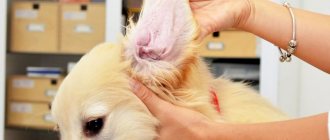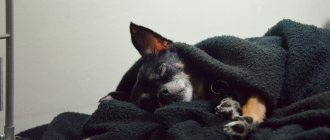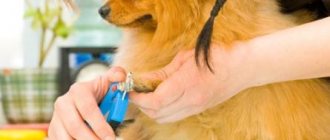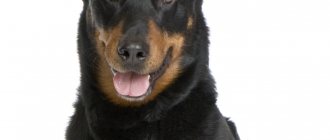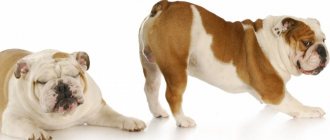Often, while stroking the dog, the owner discovers a lump on its body and immediately begins to panic, suspecting that the pet has a dangerous disease. Of course, fears may not be groundless.
It is likely that the lump under the skin has a cancerous etiology, but you should not sound the alarm without showing the animal to the veterinarian, because neoplasms may be harmless and may not even require treatment.
Causes of the disease
Lumps under the skin in different parts of the body can have different origins - a bee sting, a malignant or benign neoplasm, an abscess, etc. Some swellings go away after a couple of days, others increase in size over time and begin to cause serious discomfort to the pet.
The main reasons for the appearance of bumps on a dog’s body are:
- injury;
- viral infection;
- damage to blood vessels after surgery;
- oncology;
- penetration of bacteria.
If the subcutaneous lump does not go away after two days and bothers the animal, contact a veterinary clinic.
Where to go? Which clinic will help?
Moscow
- State Vet . One of the Moscow clinics with an impeccable reputation. An examination by a specialist is only 400 rubles. There is a 50% discount during happy hours, 15% for inviting a friend, call for details. Address: metro station Bratislavskaya, Bratislavskaya street, 22.
- Vetlife . Clinic with modern veterinary equipment. A veterinary pharmacy and a grooming salon are also at your service. Initial appointment is 600 rubles. Address: Beskudnikovsky Boulevard, 12.
- Vega . The Vega network of veterinary clinics began its existence in St. Petersburg. A branch has recently been opened in Moscow. There is a 40% discount on medical examinations for older cats and dogs. Initial appointment is 765 rubles, appointment with a dermatologist is 1500 rubles. Address: Marshal Katukova Street, 17k1, 2nd floor.
Saint Petersburg
- Chelsea . Veterinary clinic with excellent reviews. Animal owners note the high professionalism of veterinarians and groomers, and the responsiveness of administrators. The clinic offers a 10% discount on services on Tuesdays and Fridays. Specialists carry out home visits, cost from 1000 rubles. Address: Budapestskaya street, 36k2, ground floor.
- Vetmir . Modern clinic with good equipment. The reviews note that the clinic’s doctors are not only highly qualified specialists, but also good psychologists. They easily find contact with animals, explain in detail the tactics of action and prognoses for further treatment. Admission costs from 500 rubles. Address: Komendantsky Prospekt, 51 k1, ground floor.
- Clinic Bars . The initial appointment is only 290 rubles. Wide range of veterinary procedures. The staff is very friendly and takes their work responsibly. Address: Alexandra Matrosova street, 9, 1st floor.
Krasnodar
- Help paw . The clinic has modern equipment and conducts laboratory tests. There is a hospital and a pet hotel. The owners praise the staff for their simple human attitude, responsiveness and quality work done. Initial appointment is 300 rubles. Address: Architect Ishunin Street, 7/1 bldg.
- Nika Clinic . The extensive experience of our specialists allows us to quickly and accurately carry out only the necessary research. You can call a veterinarian at home. Stavropolskaya, 107/10, ground floor.
- Veterinary site . The clinic carries out laboratory tests. It has its own pharmacy, which is very convenient for owners leaving the reception. Address: Zavodovskogo, 23, ground floor; entrance from the street Komarova.
- Clinic "Na Babushkina" . Has been carrying out its work for more than 20 years. The clinic’s veterinarians are guided by the principles of evidence-based medicine. Address: Babushkina street, 160.
Quantity
Main symptoms
There is no single clinical picture for bumps on a dog’s body, since they can be caused by different diseases, each of which has its own characteristic signs.
So, with an abscess that occurs under the influence of a bacterial infection that enters the body through a bite, puncture wound or scratch, the dog experiences swelling, fever, and pain. The lump swells for several days, after which it begins to fester.
Smooth-haired dogs often develop papillomas and warts on their bodies. The cause of their occurrence is considered to be a viral infection. The growths on the skin are usually brown in color and are painless, but it is still worth consulting a veterinarian.
The dog may develop a hematoma as a result of bruises or fluid accumulation when blood vessels are damaged during surgery. It is a formation that changes the shape of the part of the body where it is located. It does not cause discomfort to the dog, however, if the hematoma does not go away for a long time, consultation with a specialist will also be required.
A cyst can appear anywhere: both on the body and on the dog’s face, for example, at the junction of the jaws. Upon inspection, it is quite easy to detect. It appears as reddish, painful abscesses that the dog tries to lick.
Pyoderma is a purulent inflammation of the skin in dogs, which is accompanied by a rash and papules. Swellings can form all over the body, paws, in folds of skin, and on the face.
Insect bites (bees, ticks and even mosquitoes) can cause painful swelling. The most dangerous bites are to the face and mouth.
There are two types of tumors in dogs: benign and malignant. Benign tumors grow slowly and, as a rule, do not cause discomfort to the dog. Unlike malignant tumors, they do not metastasize. However, this does not mean that they do not pose a danger to the health of the animal, since over time they can degenerate into cancer.
Malignant tumors appear as a result of cell mutation. Cancerous tumors are characterized by rapid growth, absence of symptoms at the initial stage, and metastases. Sometimes the bumps break through the skin and bleed. As the disease progresses, an increase in symptoms is observed.
Is it possible to cure a tumor or thickening of the skin?
After diagnosis, your veterinarian will suggest treatment options. Even if a dog is diagnosed with a malignant neoplasm, treatment can give excellent results. Active medical intervention at an early stage can help with this. Proper nutrition helps in the treatment and prevention of skin pathologies. The right balance of nutrients in the food can help soothe irritation and generally keep your dog's skin and coat healthy.
The key to a positive outcome is early identification of the problem and treatment. Therefore, it is important to photograph a raised or flat lump on your dog’s skin and see a veterinarian for diagnosis as soon as possible. This is the easiest way to help your pet live a long, healthy life.
Diagnostics in a veterinary clinic
To make a correct diagnosis of a dog, a veterinarian will need to examine the animal and do a number of necessary diagnostic tests, including:
- general and biochemical blood tests;
- Analysis of urine;
- Ultrasound;
- biopsy for histological examination of tissue;
- fingerprint smear - to determine cell atypia or the presence of an infectious agent;
- computed tomography - if a malignant tumor is suspected;
- radiography - to determine the depth of penetration of the lump into the soft tissue.
According to indications, additional diagnostic methods can be used to obtain more complete information.
How serious are bumps in dogs?
In many cases, your veterinarian will be able to diagnose your dog's lumps and lumps by performing a complete physical examination. However, in some cases, tissue samples may need to be collected to determine the cause of the growth.
- Skin scraping or stamp smear
- Fine needle aspirate
This test requires inserting a needle into the lump to extract cells for evaluation.
- Biopsy
This is a small operation to obtain tissue samples.
Treatment method and prognosis
After making a diagnosis, the doctor develops a treatment regimen. For each individual case, it will be individual depending on the disease, the severity of the animal’s condition, age, and tolerance (intolerance) to medications.
For cancerous tumors, drug treatment is not effective, since no drug can stop the development of the tumor. Radiation therapy, chemotherapy, and surgery to remove the tumor are indicated. After surgery, the course of chemoradiotherapy is repeated.
Benign tumors are removed surgically.
Treatment of abscess is also surgical. The inflamed area is opened, the open wound is washed, and Levomekol ointment is injected through the installed drainages.
The prognosis depends on the diagnosis. In most cases it is favorable, with the exception of malignant tumors. Cancer responds well to treatment if you contact a specialist in the initial stages of the disease. So, at stages 0, I, cancer is curable by 90%, at stages III, IV - by 50%.
General symptoms
Typically, subcutaneous bumps do not bother dogs in any way, even if they are in the active growth phase. Depending on the cause of origin, spherical seals can have different densities and diameters - from several millimeters to several centimeters. Skin irritation and itching usually occurs with insect bites. In other cases, the lump can only be detected tactilely. In short-haired breeds, “defects” are noticeable visually, but in long-haired breeds they are diagnosed only by palpation.
If the appearance of the lump is suspicious, and the ball under the skin does not resolve within 7-10 days, then the dog must be shown to a veterinarian. The following symptoms may alert the animal owner:
- The dog reacts painfully to palpation of the lump.
- The lump “grows” before our eyes, increasing in size several times in a short time.
- The subcutaneous tissue is opened, and pus or other discharge begins to ooze from the wound.
- The color of the skin around the lump changes.
- The pet becomes apathetic, eats poorly or refuses to eat at all, and sleeps anxiously.
Hematoma due to trauma
Back injuries pose a significant risk. Hematomas along the spine can be not only subcutaneous hemorrhages resulting from bruises, but also traces of closed fractures or displacements of the vertebrae. Self-diagnosis is unacceptable; you don’t even need to feel your back along the spine. This can cause the dog a lot of pain and complicate the fracture if there is one. It is necessary to ensure maximum rest for the animal and then take it to a veterinarian. It is best to immediately choose a clinic where there is an X-ray room in order to reduce the hassle of traveling for your pet.
A special type of injury is typical for small dogs - falling from a small height onto their back. It’s hard to imagine, but a dachshund falling belly up from the sofa can actually injure its spine. If a bruise is suspected, there is no need to wait for the moment when the dog has a lump on its back after a fall. It is worth taking your pet to a veterinarian on a preventive basis and providing him with maximum peace. Active games will be allowed after full recovery.
Other localizations
The tumor appears on the paws. There are soft and hard. The first indicates skin cancer. The second is about bone disease. Gradually seizes the limb.
Soft spreads by metastases in the blood. Is it dangerous. New areas appear randomly. The hard one captures, in addition to the limb, other bones.
Ear lumps appear. If blood vessels rupture inside the tissue, a hematoma appears. But sometimes cartilage cancer is found. It grows deep into the skull and affects the brain.
The neck is also at risk. Mastocytoma occurs. Cells grow quickly and reduce immunity. Sometimes it compresses the esophagus and respiratory tract. Possible death.
Kinds
Conventionally, all neoplasms can be divided into two groups: benign and malignant. The first include:
- Abscess. It looks like a lump filled with pus inside. It may appear as a result of a bruise, a fall, an unsuccessful injection or other damage to the skin. There are superficial and deep abscesses. The first is formed in the upper subcutaneous layer; it is easy to detect by swelling of the tissues and their red color. Deep affects internal organs and is not visually diagnosed.
Quite often, dogs experience inflammation of the paraanal glands, which leads to the appearance of lumps around the anus. When the problem is aggravated by infection, the area becomes very swollen, accompanied by an unpleasant odor.
- Papillomas and warts. Frequent companions of smooth-haired dogs. The disease is transmitted through contact with a carrier of the virus. Formations can appear either singly or crowded. They hang in “clusters” on individual parts of the body, having a branched structure and dark coloring. Loose and soft to the touch.
As a rule, papillomas appear in the mucous membranes (mouth, eyes), as well as on the abdomen, groin areas and armpits. Despite their unaesthetic appearance, hanging “balls” may not cause any trouble to the animal, but if they begin to change color or bleed, then you should immediately see a veterinarian.
- Hematoma. The cause may be vascular ruptures and, as a result, hemorrhage into adjacent tissues. The accumulation of excess fluid leads to the formation of lumps, which can either go away on their own or be opened surgically.
Most often, hematomas appear as a result of bruises or blows, as well as various medical procedures. The more damaged the vessel is, the larger the lump grows. The dog may react to the problem with an increase in body temperature, poor appetite, nervousness, or, conversely, apathy. Sometimes there may be enlargement of the lymph nodes.
- Cyst. It is always localized in the superficial layer of the skin, has a round shape and usually does not “respond” with pain when pressed. The size can vary between 2-5 cm in diameter, it feels loose and soft to the touch. A cyst-shaped ball can be found under the skin anywhere due to blockage of the gland ducts. Depending on its location, the cyst may not cause any discomfort to the dog or, on the contrary, interfere with movement, chewing food, lying on its side, etc.
- Pyoderma. Predisposition to the disease persists in puppies up to 4 months of age. The bumps appear suddenly and are spontaneous in nature. They quickly spread throughout the body, degenerating into purulent boils. Often they open spontaneously and take the form of fistulas. Accompanied by itching and scabies.
The most vulnerable to pyoderma are dogs of small breeds (Chihuahua, Yorkshire terrier), as well as boxers, sharpeis, and French bulldogs.
A separate category includes insect bites - spiders, wasps, ants, hornets. A severe swelling occurs at the site of the bite, which is painful, itchy and itchy. Due to the fact that the dog scratches the sore spot with its paws, the lump may not heal for a long time and turn into an open wound.
The most unfavorable development of the situation is the development of benign formations into malignant ones. It is impossible to predict the speed of the process, everything is individual. The bumps may not bother the dog for years, and then begin to change, or they can actively grow and immediately serve as a source for the spread of metastases throughout the body.
Older animals are at greater risk of developing sarcoma, but fibrosarcomas can affect small puppies under 6 months of age. Visually identifying a malignant tumor is possible only in the later stages.
Prevention
Unfortunately, there is no prevention for most tumors. The exact reasons for their appearance have not yet been established; it is believed that ultraviolet and ionizing radiation, poor ecology and other factors that are extremely difficult to exclude from a pet’s life play a role in their development. Breast tumors can be prevented. There are studies according to which females spayed before their first heat have a less than 0.05% chance of developing such a malignant tumor. Then, with each heat, this percentage increases. Castration after the age of two years does not reduce the risk of developing neoplasms. Also, eliminating the use of hormonal medications to stop estrus reduces the risk of developing cancer.
Abscesses can be prevented by avoiding self-walking and fights between dogs. It is impossible to predict the development of an allergic reaction to something. But if the allergen is known, then contact of the dog with it should be excluded. Hernias are often congenital, which cannot be prevented. But traumatic hernias can be avoided if you always keep an eye on your pet while walking.
